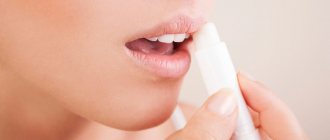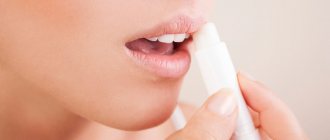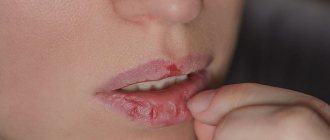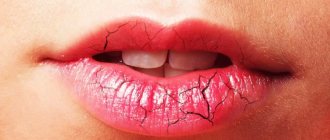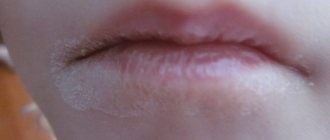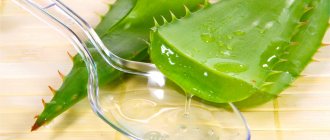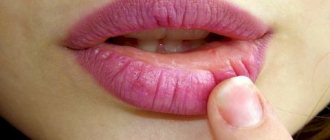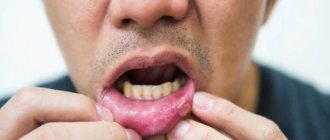Dermatovenerologist
Khasanova
Alina Rashidovna
9 years experience
Make an appointment
Patients often consult a doctor complaining of inflammation in the red border or mucous membrane of the lips. In most cases, a specialist diagnoses “cheilitis”. This is the name for tissue inflammation, which manifests itself in the form of redness, peeling, the appearance of purulent crusts and weeping ulcers. Any attempt to open the mouth when eating or communicating causes sharp pain associated with tissue damage. Without proper treatment, the disease persists for a long time, causing the patient a lot of physical and aesthetic inconvenience. For young people, the prognosis after clinical treatment of cheilitis is completely favorable, but older patients may encounter its complications in the form of leukoplakia and the onset of the oncological process.
Reasons for development
In the clinical practice of most specialists, there are cases where cheilitis on the lips developed on its own or was a side effect of a serious disease of the internal organs or damage to the mucous membrane. Among the most likely causes of the development of the disease are:
- inflammation of the mucous membrane with dermatoses, erythematoses or lichen planus;
- infectious diseases: syphilis, tuberculosis, etc.;
- psoriasis and other skin problems.
Among the unfavorable external factors, it is worth noting an excessive amount of ultraviolet radiation, strong wind, flows of cold or hot air from climate control equipment or ventilation in industrial premises. Signs of cheilitis are often observed in people who work in open areas in direct sunlight.
A separate group includes manifestations of allergic cheilitis, which developed after contact of the lip mucosa with aggressive chemicals or prolonged exposure to ultraviolet radiation. Sometimes doctors observe the clinical picture of secondary cheilitis, when the development of the disease is caused by eczema, neuritis of the facial nerve, pathologies of the muscles and tissues of the facial part of the skull.
Folk remedies for the treatment of chapped lips
In folk medicine, there are many remedies that help cope with chapped lips. Below we will tell you what to put on your lips and how to quickly cure chapped lips.
Application of oils
It is best to use the following oils for healing your lips: sea buckthorn, olive, calendula and rosehip. If desired, they can be mixed with a solution of vitamins.
Preparing the product is quite simple. Mix 20 ml olive oil and 2 drops of vitamin A solution and 2 drops of lemon juice. Apply the resulting composition 2 times a day to your lips until they are completely healed.Compresses
Another effective remedy for eliminating chapped lips are compresses. To prepare them, use the recipes below.
Coffee compress
Ingredients:
- coffee grounds - 1 tbsp;
- oatmeal - 2 tbsp.
How to prepare: Mix the ingredients and then wrap them in gauze.
How to use: Apply the gauze to your lips for 20 minutes.
Result: Relief of chapping symptoms.
Salt compress
Ingredients:
- warm water - 1 glass;
- salt - 0.5 tsp.
How to prepare: Dissolve salt in water.
How to use: Soak gauze in saline solution, then apply to lips for 10 minutes. Lubricate the skin with cream.
Result: Elimination of signs of weathering.
Peeling
The most effective folk remedy for eliminating chapped lips is peeling. The procedure helps remove dead pieces of dermis that cause discomfort.
For peeling, you can use candied honey or granulated sugar with olive oil. Apply this product to your skin, then remove and wipe the skin on your lips with a soft toothbrush.
Ointments, masks and creams
These products have gained popularity among women of all ages. It is quite simple to prepare ointments, masks and creams at home to restore the skin of the lips.
If you have an avocado on hand, you can use it to eliminate chapping. To do this, apply the pulp of the fruit to your lips, and wash it off after half an hour. The product helps retain moisture and makes lips soft.
You can also use regular honey to improve the condition of the skin on your lips. To do this, just apply honey to your lips and wash it off after 20 minutes, then lubricate it with olive oil. This procedure should be repeated every 2 hours.
What to do when your lips become chapped in summer? Just use one of the recipes below.
Sea buckthorn oil mask
Ingredients:
- honey - 50 g;
- glycerin - 20 g;
- propolis tincture - 10 ml;
- sea buckthorn oil - 15 g.
How to prepare: Melt the honey, then add the rest of the ingredients. Mix thoroughly.
How to use: Apply the mask to your lips 2 times a day.
Result: Improving the condition of the skin of the lips and eliminating signs of chapping.
Aloe mask
Ingredients:
- Vaseline - 10 g;
- glycerin - 10 g;
- aloe juice - 1 tsp.
How to prepare: Mix the ingredients.
How to use: Apply the mask on your lips for half an hour, then rinse with warm water.
Result: An aloe-based product heals cracks and restores them in a short time.
Curd mask
Ingredients:
- cottage cheese - 20 g;
- cream - 2 tsp.
How to prepare: Mix ingredients.
How to use: Apply the composition to your lips. Wait until the mask dries completely, then rinse off.
Result: The curd mask helps soften, strengthen and moisturize the skin.
Cocoa butter ointment
Ingredients:
- Vaseline - 1 tsp;
- cocoa butter - 1 tsp;
- beeswax - 1 tsp;
- chamomile decoction - 1 tsp.
How to prepare: Mix the ingredients of the ointment.
How to use: Apply the ointment to clean lips twice a day.
Result: Elimination of chapped lips.
Symptoms and signs depending on the type of cheilitis
The accepted classification of cheilitis makes it possible to clearly establish the type and causes of the disease, as well as to identify the characteristic signs of the pathological process:
- Exfoliative cheilitis is localized on the red border of the lips. It has a clear gender link: it occurs more often in women. The main symptom is peeling of the lips due to neurological disorders: stress, depression, anxiety. Often the inflammatory process develops against the background of hyperthyroidism, or intense activity of the thyroid gland. The danger of exfoliative cheilitis is its ability to be inherited as a genetically fixed change in the body’s immune system.
A feature of exfoliative cheilitis is localization only on the red border of the lips, while the mucous membrane and skin around the mouth remain intact. In most cases, only part of the border is affected, while areas at the corners of the mouth usually retain their appearance. If a patient has dry skin, he often complains of tightness of the lips, the appearance of scales, and a burning sensation. It is almost impossible to completely cure exfoliative cheilitis. The disease proceeds along a sinusoid, sometimes exacerbating, sometimes disappearing under the influence of medications and external factors. Without medical supervision and if you refuse to take a course of treatment, large bleeding crusts form on the lips, which cause discomfort during conversation and eating.
- Glandular cheilitis develops against the background of pathological proliferation of the salivary glands. A humid environment creates favorable conditions for pathogenic microorganisms, as a result of which the mucous membrane becomes easily infected. If the pathology of the salivary glands is congenital, the probability of developing glandular cheilitis is 100%. The risk group also includes patients with dental problems: untreated caries, periodontitis, tartar, etc.
In some cases, glandular cheilitis develops as a result of damage from waste products and the breakdown of pathogenic microorganisms. The disease is more often diagnosed in patients over 30 years of age and is localized on the lower lip. Primary symptoms are dry lips and the appearance of painful cracks. Usually these symptoms are ignored, and attempts are made to combat them with local cosmetic products. Without treatment, the problem worsens: erosions and bleeding wounds appear at the site of cracks. Involuntary licking of dry lips aggravates the pathological process, which leads to their further dryness.
- Contact allergic cheilitis is caused by exposure to an external allergen. This could be the chemical composition of lipstick, microorganisms on the surface of pencils or pens, which the patient is accustomed to often holding in his teeth during work or creative activities. Cheilitis is considered an occupational disease among musicians who are forced to hold the mouthpieces of instruments in their mouths for a long time. The symptoms of this type of pathology are quite common. Patients complain of itching, swelling, burning and inflammation of the lips. After prolonged contact with the allergen, blisters appear on the skin, the rupture of which opens small ulcers and erosions. In the chronic stage, the disease makes itself felt only with minor itching and peeling.
- Meteorological or actinic cheilitis is a reaction to weather conditions. For a sensitive organism, radiation, wind, cold or solar radiation are equally dangerous, provoking the appearance of characteristic symptoms: burning and itching, large crusts and erosion of the mucous membrane. With prolonged exposure to unfavorable climatic factors, the formation of small bubbles with liquid contents is possible. The dry form of cheilitis is considered the most dangerous for patients. Its first symptoms in the form of itching and burning are harmless. However, with prolonged development and lack of treatment, malignancy is possible - the degeneration of affected cells into a malignant formation.
- Atopic cheilitis is a type of skin disease: atopic dermatitis and neurodermatitis. The disease develops against the background of an allergic predisposition of the body, which reacts to cosmetics, perfumes, food and exposure to pathogenic bacteria. In addition to the usual symptoms, there is dryness and damage to the skin in the corners of the mouth, and intense peeling of the face.
- Hypovitaminous cheilitis develops against the background of a lack of B vitamins in the body. Patients usually complain of dryness and burning of the tongue and lips. Vertical cracks and small peeling scales are visible on the skin. The tongue increases in size, and teeth marks become visible on it.
Are you experiencing symptoms of cheilitis?
Only a doctor can accurately diagnose the disease. Don't delay your consultation - call
Corticosteroid ointments
Ointments based on corticosteroids - artificial hormones of the adrenal cortex - relieve inflammation and reduce local allergies. They are single-component, that is, with one active ingredient (Hydrocortisone, Flucinar, Prednisolone, Beloderm, Elokom) and combined (for example, Oxycort, Mycozolon), in which corticosteroids are combined with antibiotics or antifungal drugs.
It is not recommended to use such ointments on your own, since they do not work against bacterial infections, and only a doctor can determine the cause of cheilitis. Some of them are contraindicated for children, others are used with restrictions in children.
Prednisolone ointment 0.5%, Beloderm
Prednisolone not only has an anti-inflammatory effect and reduces allergies, but also dries out the skin with weeping dermatitis. It is also prescribed for neurodermatitis, eczema, systemic lupus erythematosus (cheilitis is one of the symptoms of this disease). Beloderm contains a synthetic analogue of prednisolone - betamethasone dipropionate, it has a similar effect and is prescribed in the same cases.
Usually, one to two weeks are enough for wounds to heal. Prednisolone and Bepanten can be used in young children from one year of age, but not longer than a week. Both ointments not only do not help, but are also contraindicated for bacterial, viral, and fungal infections.
Hydrocortisone 1% Oxycort 1%
The synthetic hormone hydrocortisone contained in the ointment of the same name Hydrocortisone 1% relieves inflammation, reduces itching, wounds stop getting wet and heal faster. The ointment is prescribed as a local antihistamine for allergic dermatitis.
Oxycort (another trade name Hyoxysone) is a combination drug that includes hydrocortisone and the antibiotic oxytetracycline. Oxycort and Hyoxion are prescribed for bacterial inflammation or if atopic cheilitis is complicated by a bacterial infection. It is allowed to be used in children over 2 years of age, but children are prescribed for no longer than a week.
Flucinar
The active substance of Flucinar is the glucocorticosteroid fluocinolone acetonide. This is an anti-inflammatory, anti-allergic ointment, it reduces the skin's sensitivity to local allergens. Unlike many ointments, it can be applied to damaged areas of the epidermis, and the effect of the ointment is enhanced. Flucinar is used in a short course for acute non-infectious inflammations of the skin with severe itching and peeling, including atopic dermatitis. It does not help and is contraindicated for any skin infection - viral, bacterial, fungal. Children are not allowed to apply it to their face!
Mycozolon
A combination ointment, like Oxycort, but in addition to the corticosteroid (mazipredone) it is not a highly specialized antibiotic, but the antifungal and antibacterial drug miconazole. It acts on almost all dermatophytes - fungi that cause skin diseases, and on some types of pathogenic bacteria.
Lubricate the corners of the mouth affected by the fungus several times a day until the skin is healed. This usually takes one to two weeks.
Treatment of various types of cheilitis
The course is developed taking into account the type of diagnosed disease and the general condition of the body.
- For exfoliative cheilitis, additional consultations with a neurologist and neuropsychiatrist are recommended. The patient is prescribed a course of sedatives. Effective methods of local treatment include laser therapy, ultrasound or radiation therapy, and the use of moisturizing cosmetic creams and ointments. According to indications, hormonal medications and vitamin complexes are prescribed.
- Glandular cheilitis is removed with anti-inflammatory ointments. Local treatment consists of cauterization or desquamation of enlarged salivary glands, and during the rehabilitation period, the use of drugs to eliminate dryness or excess moisture of the mucous membrane.
- When treating atopic cheilitis, the goal is to eliminate any irritating factors. The local course is based on the use of anti-inflammatory and anti-allergic drugs in the form of external ointments. Patients are also recommended to have a hypoallergenic diet that excludes the consumption of fish, citrus fruits, spicy foods and alcohol.
- For meteorological cheilitis, treatment tactics include taking vitamin preparations, using local healing agents and ointments with a high UV filter.
Timely initiation of treatment and the patient completing its full course guarantees relief from the unpleasant symptoms of cheilitis with a long-term effect.
How to cure jams in the corners of the lips in children
If angulitis occurs, first of all you should consult a doctor for advice.
It is very important to identify the cause of the disease so as not to provoke a relapse. In the future, an integrated approach to treatment is provided
The most common method of therapeutic intervention is medication, which is characterized by the following measures:
- Lubricating the corners of the lips with healing compounds. If the cause of angulitis is a candidiasis infection, then use the antifungal ointment Clotrimazole. When bacteria are the provoking factor, antibacterial compounds are used, for example, Tetracycline and Erythromycin ointments. Methyluracil and Levomekol, which are also used to lubricate the affected area several times a day, have an excellent healing effect. The course of treatment is at least a week. In the presence of deep cracks, topical glucocorticoids are used, for example, Hydrocortisone cream, which promotes rapid tissue restoration.
- Taking homeopathic remedies. Echinacea tincture is especially effective in stimulating the immune system. It is used only with a doctor’s prescription and is used for at least a month, adding a few drops to water once a day.
- The use of vitamin therapy. This method of treatment is especially important, since pockets in the corners of the mouth often provoke a deficiency of nutrients in the body. To compensate for the lack of necessary elements, taking vitamin complexes such as Pikovit, Complivit and Alphabet is recommended.
Treatment with glucocorticoid ointments is also not recommended for children aged 5 years. At this age, the body is sensitive to antibiotics, so such drugs are used only topically
The importance of hygiene needs to be taught to 5-year-olds so that they understand the dangers of licking dirty hands.
Children aged 7 and 10 years old require a comprehensive approach to therapy. You need to use the remedies listed above and be sure to ensure that the child does not eat dirty fruits or lick his lips during the frosty season.
It is necessary to convey to children the importance of school meals and eliminate all dry snacks from the diet
Additional treatments
When treating angulitis, it is very important to follow a diet. At the same time, citrus fruits should be excluded from the child’s diet during therapy, as they irritate the corners of the lips and can aggravate the situation.
To improve immunity and speed up the healing process, it is recommended to eat more plant foods: fresh vegetables and fruits. It is good to include foods rich in B vitamins in your diet. These include:
- oatmeal;
- buckwheat;
- almond;
- Walnut;
- fish;
- pasta;
- wheat;
- corn.
Traditional methods of treatment are also used quite often. For the treatment of children they are used only externally:
- Juice from fresh cucumber and aloe. This will require both ingredients in equal quantities. Squeeze 20 ml of juice from aloe and cucumber and mix. Then add 1 dessert spoon of Kalanchoe contents. Mix everything again and use 3 times a day to wipe cracks for at least a week.
- Propolis. To prepare the healing composition you will need 0.5 tsp. beekeeping product and 5 tsp. melted butter. Propolis must be thoroughly crushed and placed in a glass container. Then add warm oil and mix thoroughly. Use the mixture 3 times a day to treat problem areas for a week.
- Green tea. The large-leaf version without flavorings has an excellent effect. A strong brew will be required. For this you need 1 tbsp. l. green tea, pour 250 ml of boiling water and let stand for 20 minutes. Then you should soak a cotton pad in the tea leaves and apply it to the affected area for 5 minutes. The procedure must be carried out 2 times a day for 10 days.
How is glandular cheilitis treated?
Treatment of simple glandular cheilitis is necessary for complaints of continuous salivation, as well as for inflammatory phenomena of the mucous membrane and red border of the lips.
The most reliable method of treatment is electrocoagulation of the salivary glands through a hair electrode in the gland duct. This treatment method is possible with a small number of hypertrophied glands. In case of multiple lesions, cryodestruction or surgical excision of almost the entire Klein zone is possible.
For secondary glandular cheilitis, the underlying disease is treated.
MedTravel Treatment abroad » Dentistry » Glandular cheilitis of the lips
Diagnostics
Although the external manifestations of the disease are quite characteristic, for a complete clinical picture it is necessary to use histological examination. A biopsy of the affected salivary gland will help establish the most accurate diagnosis. Changes in epithelial tissue in patients may vary from person to person: in some patients parakeratosis or acanthosis may be noticed, while in others no changes occur. Cheilitis is characterized by the absence of the granular layer of the epithelium, while the spinous and basal layers, as a rule, remain unchanged.
